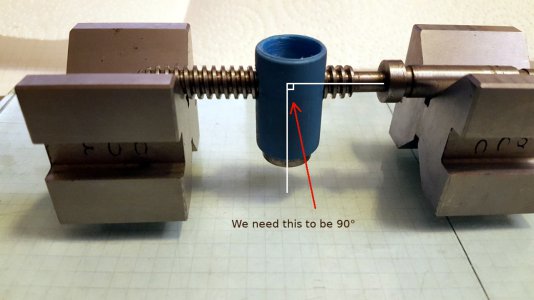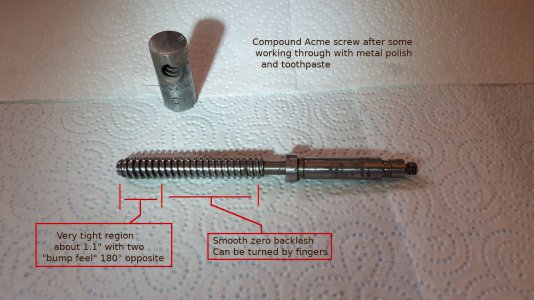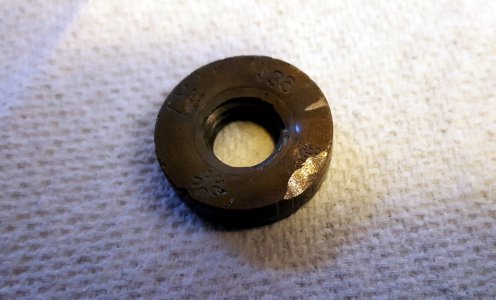-
Welcome back Guest! Did you know you can mentor other members here at H-M? If not, please check out our Relaunch of Hobby Machinist Mentoring Program!
You are using an out of date browser. It may not display this or other websites correctly.
You should upgrade or use an alternative browser.
You should upgrade or use an alternative browser.
Atlas 618 - is this normal?
- Thread starter JRT
- Start date
- Joined
- Apr 30, 2015
- Messages
- 12,238
That is either wear of the cross slide screw and nut or the screw holding the cross slide nut is loose
Kinda normal since it falls under the heading of backlash and all machines have some
As a side note: I'm not sure if wearing rubber gloves is a good idea when machining. For cleaning and adjusting yes, but you don't want to
wear anything that might get caught and pull your hand in before you realize it
Dirty hands are better than injured ones
Kinda normal since it falls under the heading of backlash and all machines have some
As a side note: I'm not sure if wearing rubber gloves is a good idea when machining. For cleaning and adjusting yes, but you don't want to
wear anything that might get caught and pull your hand in before you realize it
Dirty hands are better than injured ones
Last edited:
- Joined
- Feb 2, 2013
- Messages
- 3,960
You may have 2 different things going on.
There may be slop in the feedscrew/ nut interface allowing the compound to move transverse.
There are supposed to be 3 pins that are retaining the compound , when the set screws are tightened against the pins, they lock the compound dovetail to the saddle .
When you loosen them you can turn the compound
There may be slop in the feedscrew/ nut interface allowing the compound to move transverse.
There are supposed to be 3 pins that are retaining the compound , when the set screws are tightened against the pins, they lock the compound dovetail to the saddle .
When you loosen them you can turn the compound
- Joined
- Apr 30, 2015
- Messages
- 12,238
2 pins actually not 3
- Joined
- May 27, 2016
- Messages
- 3,479
I looked at this carefully, mindful of what @markba633csi correctly labels as "backlash", but I would not consider that much "kinda normal".I disassembled, cleaned, oiled and reassembled the saddle and cross slide. Then adjusted the gibs as Mr Pete on YT does/advised. All is good except for this little bit of play. Is this normal or did I adjust something incorrectly?
So let's put some numbers on it. Place a dial indicator base on any bit under the part that moves, and measure how much the part above moves.
For the compound, there should be someplace on the cross slide that will do, For the cross slide, either the lower part of the saddle, or maybe on the ways is a place for the base.
Two places it can happen
Consider the compound first. Backlash can firstly be from wear in the nut, and on the most used part of the ACME screw. Then secondly, it can be thrust play in the entire lead screw relative to the compound body. I have South Bend, not Atlas, but I think the scheme is similar. The thrust slack is taken up right near the graduated dials end. Adjust it, or pack with washer or spacer such that there is near zero back and forward thrust slop. If it is sufficient to hear a "klonk" at that spot, then it is way too much. If this thrust slop point is taken care of, then the remainder is in the ACME nut and screw. Reasonable worn state backlash (my opinion) might be in the region of 0.008" to about 0.0012". If it gets beyond 0.020", I would be very unhappy.
There may be varied opinion here. Some folk have the skill to turn out very good precision work regardless they have to always be taking up what I would call spectacular backlash before they add on the depth of cut, but I have a shorter fuse when it comes to hankering to fix it.
The cross slide
The same principles outlined above are true here, just moved to a slightly lower place on the lathe.
The amount of slop clearly visible in the video is way more than acceptable, so much that I think it may not all be down to ACME nut and leadscrew wear. It looks to be something like 1mm (0.040") The klonky slop you see will be the sum combination of wear at the nut/leadscrew and the loose trust at the place the leadscrew hangs onto the cross slide upper body.
You may be able to substantially reduce the play by properly packing out the thrust surfaces behind the dials. Any left over might have you getting in some ACME leadscrew stock, and turning up a replacement adaption. There are lots of variations, ranging from purchasing replacements to joining up leadscrew stock to custom dial axle shafts using Loktite. You will be able to find YouTube videos on what folk do to make up new leadscrews to suit their machine.
Here is a start..
Last edited:
I do feel like it's more than should be there, definitely more than a few thousandths. I assume the lead screw is hardened steel and the little nut at the end is brass for the cross slide... Wouldn't the brass nut wear out and not the lead screw as brass is much softer? I'll try to get those measurements soon when I have the time to do it.
- Joined
- Aug 6, 2015
- Messages
- 4,204
I am going over my Logan lathe and was looking into a similar situation…I do feel like it's more than should be there, definitely more than a few thousandths. I assume the lead screw is hardened steel and the little nut at the end is brass for the cross slide... Wouldn't the brass nut wear out and not the lead screw as brass is much softer? I'll try to get those measurements soon when I have the time to do it.
Both the nut and the lead screw can wear and need replacement…
Here is a quote on a similar question I made specific to my lathe but might be relevant in yours as well…
“…Also, note that you may have, in addition to backlash, axial play. The jam nuts on either side of the handwheel can be adjusted to reduce axial play of the screw (endwise movement) to a minimum.
You can get a sense of how much the screw is worn by checking for backlash at several positions of the slide. Generally speaking, if the backlash is about equal at all positions of the slide, then the nut is worn, and yes, the nut will wear faster than the screw.
On the other hand, if you have little backlash when the slide is all the way out or all the way in, then the screw is worn. The middle section of the screw is where it is generally used the most and will wear more there.”
EDIT: Looking at @graham-xrf post, he covered it all in his excellent reply.
- Joined
- May 27, 2016
- Messages
- 3,479
Hard stuff up against soft stuff? So which one takes all the wear? The answer might surprise you!I do feel like it's more than should be there, definitely more than a few thousandths. I assume the lead screw is hardened steel and the little nut at the end is brass for the cross slide... Wouldn't the brass nut wear out and not the lead screw as brass is much softer? I'll try to get those measurements soon when I have the time to do it.
Hard stuff will cut into soft stuff given enough pressure, which is achieved by making the pressure point sharp. This is as true for HSS steel cutting into brass as it is for tungsten carbide getting an entry into HSS.
BUT..
The mechanisms for wear and abrasion are completely different. Consider your (non-electric) car crankshaft. It's bearing surfaces are made really hard, and have to be ground to their finish. Then consider the bearing metals. They are made of white metal, a mix of tin and alloys copper, antimony cadmium, zinc or silver. They are so soft you can mark them with a fingernail! So long as there is a film of oil, wear is minimal.
Sintered bronze, brass, and other alloys are deliberately chosen to be up against steel. If the bearing journal is cast iron, there is enough graphite in the metal to have a hardened spindle ride against it for decades, provided it has oil. ACME shafts wear from hard silica bearing dust contaminants riding in oil. Both the nut and the ACME screw will wear. It becomes a (thin) lapping compound. The abrasive embeds into the softer metal, and the truly rock hard points cut away at the hardened steel. Such a lap will wear anything, even glass.
I once made up a "bronze epoxy" ACME compound nut repair from a mix of JB-Weld and powdered bronze, using the ACME screw with release agent (wax polish) as a mold. The wear in the middle was such that I could not undo it past the unworn ends without cracking it. I had to lap the last one to get a working version. If the nut is worn, then do also critically examine the ACME screw. Getting up a new nut may only leave you with one that is OK, or a bit tight, near either end of the screw, but still somewhat sloppy in the middle.
Here is a near worst case, crappy condition case of worn nut with a split crack in it, before restoration attempts.
View attachment SB9-Compound Acme Nut2.mP4
Here is a picture of the mold getup, made from some ex-HDPE water pipe.


The bronze-loaded JB-Weld was a reasonably fast fix, but I consider it temporary. This last image is of a trial test nut, with a bit ground off to show that it is mostly bronze. It was interesting, and got me out of a problem at low cost, meaning "quickly", but I would not do it again.

For you, you might fix everything to be fully likeable if you discover the majority the slop only needed some attention to the thrust spacing or adjustments. If it is wear, then a dandy project is to get up a new nut and ACME screw. Even if you get a nut, and adapt it your lathe, or start from a piece of bronze bar, and buy a ACME tap, or go the whole way, and cut internal ACME. Whichever route you take, the payoff gain is big. Having a fully fixed up lathe, with just enough backlash to let you know where the the measure point is, will put a smile on you!
Last edited:
